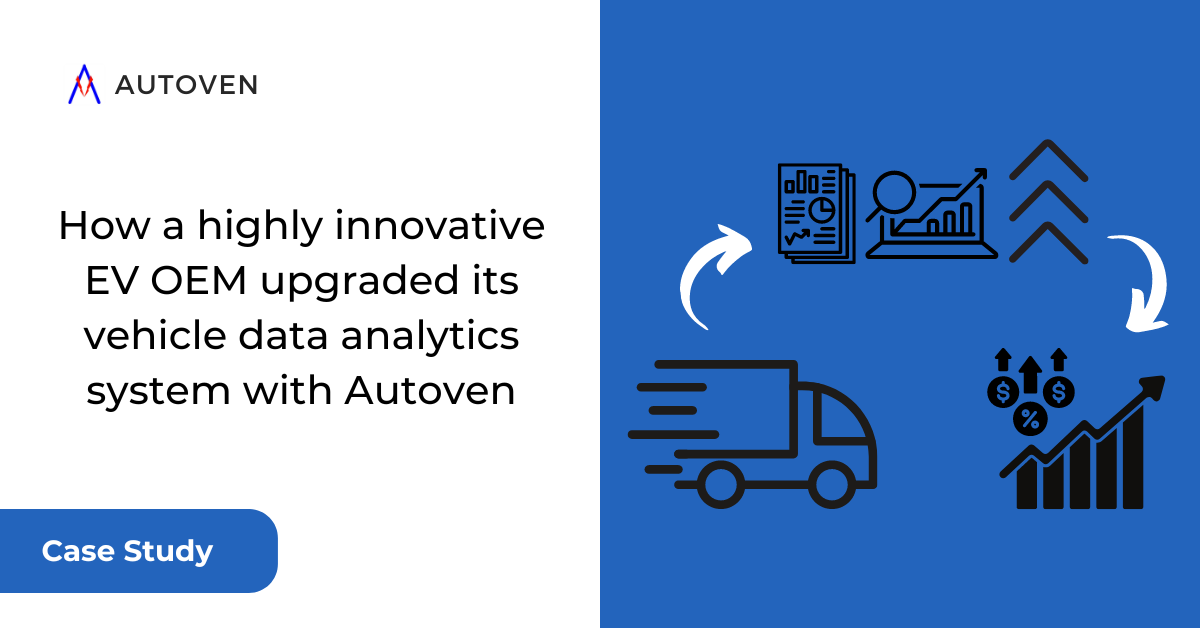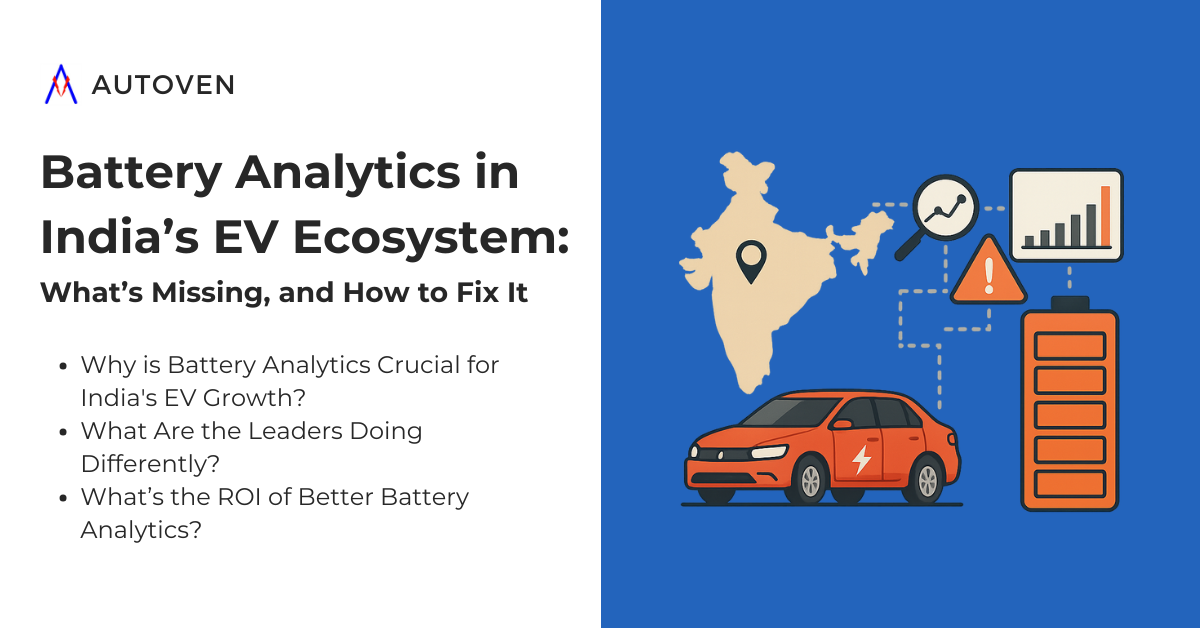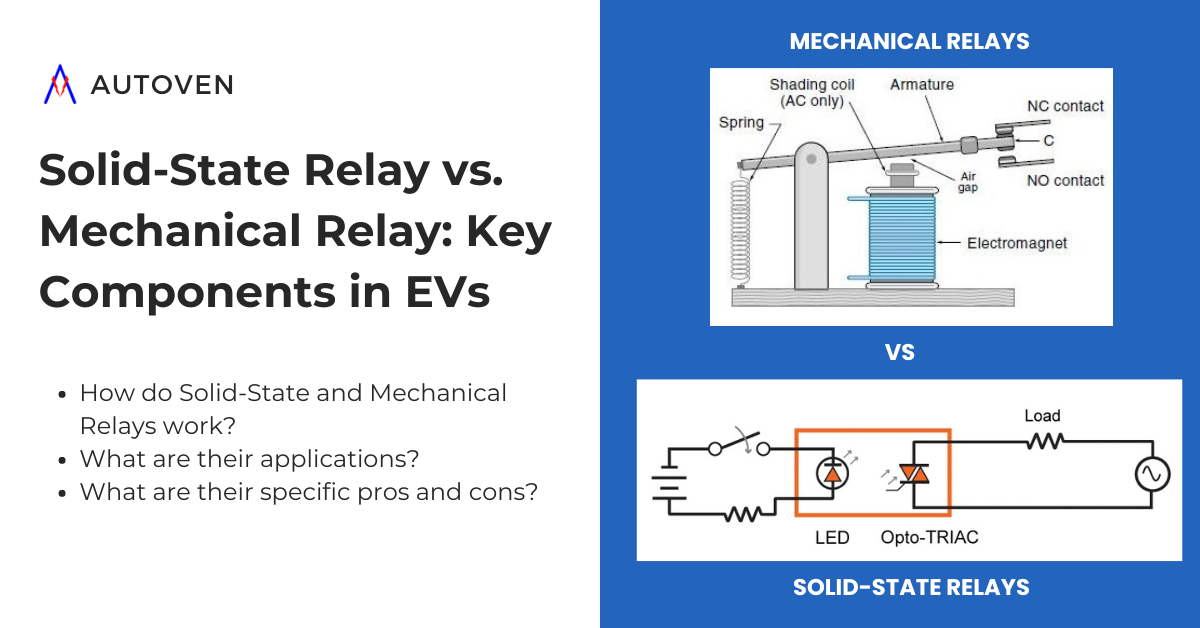Backed by Autoven’s inventive Vehicle Lifecycle Management solutions, the young company is driving alongside India’s legacy corporations.
Electric Vehicle (EV) Original Equipment Manufacturers (OEMs) globally face issues on multiple fronts. From business challenges like customer adoption and the cost of production to technological concerns like motor performance and battery life, the sustainable mobility industry’s booming rise hasn’t been entirely kind to them.
Our client, a flourishing performer in the EV space, was no exception. Having developed highly modern cargo vehicles designed to deliver outstanding performance, they were now looking to take the market by storm. With a leadership team of several technology industry veterans, they successfully designed and built robust, cost-effective, high-performing vehicles that they methodically perfected for the Indian mobility environment. They pride themselves on their technology-based approach, having secured multiple global patents in innovative EV performance systems.
However, they noticed an area of improvement: vehicle data analytics. They worked with a prototype solution that needed scalability and data recovery upgrades. Hence, they were looking to partner for a time-to-market advantage with a production-quality, scalable, and robust solution to enhance their otherwise avant-garde vehicles.
Well, Autoven offered them what they were looking for and more. Autoven provides Autoven Platform, a highly robust data pipeline with a precisely built backend server architecture that implements highly complex algorithms and a dashboard that elegantly displays analyzed data. Backed by Autoven’s solution, our client achieved their desired technological proficiency and scaled up to 10x in a year!
Reaching Out to Assist (Understanding Customer Pain Points)
Our founder, Vinay Gunasekaran, established our interaction with the client. With over 15 years of experience working in the USA and India, Vinay came in with core capabilities in data analytics and large-scale IoT deployments. Vinay completed his master’s degree at Carnegie Mellon University before joining Mathworks, where he spent five years working with several OEMs around the United States. He eventually returned to India as the R&D Head of Ecozen. Under his leadership, Ecozen created IoT solutions from the ground up, converting them into a solid framework capable of processing data obtained from over 100 thousand on-ground units.
He established the framework for our partnership with his wealth of niche experience and endeavors to fully understand the problems related to their vehicle data analytics methodology, data pipelines, and communication protocols.
Over elaborate conversations, they were able to pinpoint areas to improve upon, which are as follows:
- Data Loss
The prototype solution had no data recovery, which led to data losses in transmission from edge to cloud. That means less than a third of the data was transmitted. Such numbers are undesirable as the storage and computation of the received data become unreliable. It can lead to misinterpretation of the vehicle’s performance.
Additionally, there might be an instance where a critical data point is lost. Imagine a scenario where an overcurrent in the battery was detected but wasn’t communicated or processed due to data loss. In such cases, damage to the vehicle components is imminent. - Limited scope for scaling infrastructure
The prototype solution needed to be scalable enough to handle abundant data points. On average, one EV sends around 20,000 data packets every 24 hours. Scale that to several hundred and then several thousand EVs, and the amount of data rises exponentially and becomes impossible to manage without a sophisticated server architecture. - Fleet Management
Our client deals extensively with cargo EVs, which are logistics-related transport vehicles. Naturally, many of their customers were fleet operators from all over India.
These customers must track and monitor the performance of their vehicles. In the logistics industry, downtime leads to revenue loss. Every minute their vehicle is idle, the operators lose an opportunity to generate revenue. Also, they need to be on top of vehicle maintenance. Failure to do so will lead to revenue leakages. Their customers had communicated their needs, and the company was working hard to cater to them. - Insights on their EVs
As a young company, our client also wanted performance data from their EVs to make educated decisions about the design and performance of their products. A feedback system enables the company to redesign systems and upgrade the EV based on the data it receives.
Overall, it was evident that a robust data pipeline, scalable server architecture, and presentation of analyzed data would greatly benefit them. Autoven had all these capabilities and more, which our team enlightened them about. While gauging the extent and complexity of their challenges, our team was also able to present Autoven’s solutions as a means to mitigate these challenges. Autoven offers its clients comprehensive solutions on IoT and data analytics for EVs. It takes care of the data channel end-to-end and renders the analyzed data in a highly engaging format. Our server architecture can efficiently communicate and analyze critical vehicle data and pre-process critical insights, keeping them ready for consumption when needed, which is vital to derive intelligent insights, specifically for EVs.
Showcasing our Abilities (Establishing the scope of our solutions)
Autoven has a team of highly skilled individuals from esteemed universities globally. In close coordination with the client’s team, Autoven has built a sturdy data pipeline to achieve a hit rate of over 99.5% at data transmission. Such numbers ensure that critical data points get communicated and that data collection and analysis are highly reliable. The immaculate design of the data sender (IoT device) and the data receiver (Cloud Server) keeps them highly available, enabling them to achieve such favorable data hit rates.
Additionally, Autoven employs a highly scalable and sophisticated backend server architecture. Our server architecture comprises two distinct sets, each serving different purposes. The first set of servers is focused on collecting data without any loss, ensuring a seamless and uninterrupted process. We design these servers to be lean, optimized, and robust, minimizing the chances of errors or interruptions leading to data loss. The scalability is achieved by keeping the server as lean as possible. A lean server exclusively pulls and pushes data along the pipeline that runs from the vehicle sensors to the server stack. The data pipeline is uninterrupted, delivering high uptime for the stack.
The design ensures that the server is highly available for data transmission. This architecture is a critical feature for optimum data capture from an EV. Generally, it is easy to overwhelm a server stack in the case of EVs due to the sheer volume of data points. If a server cannot handle data briefly, it can lead to mishaps and losses. Therefore, a lean server stack is one of the most sought-after details in an EV data analytics solution.
Discover more about designing solutions with zero data loss in detail in our blog.

The second set of servers are the processing servers. They are responsible for running complex computational algorithms and are designed to achieve high levels of accuracy. Intelligent insights from the EV are made available to clients with their help. The processing server stack can run advanced scripts, including complex math algorithms, to acquire important information from vast amounts of data. These algorithms are heavy on the server but are dedicated to data analysis and don’t engage in acquiring data from the vehicle. The running of scripts is scheduled in a way that while the processing is not affected by overload, it adheres to its purpose of computing essential data efficiently.
For instance, a script may run every 10 minutes to keep track of actively encountered data. At the same time, a script may also run only once a day, early in the morning, and generate reports based on the entire day’s data.
The sophisticated server architecture is what sets Autoven apart from the alternatives. The intricate design of servers is laborious to replicate. The ability to combine robust pipelines with a powerful processing capability is a rare commodity among other solution providers. Here are a couple of reasons why:
- Velocity of Data
As the EV numbers rise to lakhs, the number of data points arriving will overwhelm the servers. In a fully functional fleet, there will be idle vehicles, vehicles running at working capacity, and those running at maximum capacity. The diversity of data points will cause non-deterministic behavior in servers incapable of compartmentalizing processes. Communication will be affected if computation is working on the same stack. This phenomenon pushes data analytics into chaos territory. Memory errors, processor overload errors, and connection time-outs due to unresponsive units will hamper the data flow. Data points will start accumulating at the source, adding to the disruption.
While there is a functionality that can help delay the disruption, it is not a permanent fix. Our solution takes advantage of the flash memory onboard the edge device that can hold onto a certain amount of data in cases of connection failures. The objective of the functionality is to prevent data loss when the vehicle travels through a poor network area. It might help during minor disruptions, but the critical problem, the volatility of server behavior, persists. - Execution of Complex Analytical Algorithms
Creating intelligent insights from vehicle data requires executing complex analytical models that consume high computing power. With a non-compartmentalized server stack, the more CPU usage taken up by the analytics, the less there will be for data transmission. At the scale of data points at which large fleets will operate, the disruption of data flow is inevitable.
Moving to the final aspect of the solution, the dashboard. Autoven has built a dashboard to display all the data post-analysis engagingly. The results of the complex data analysis models are available in the form of accessible infographics on a dashboard that is easy to navigate. The CIO of our client, who was actively looking for partners to upgrade their data analytics solution, commented that the dashboard is ”aesthetically pleasing and very minimal.” While a few alternate solutions offer vehicle data visualization capabilities, they lack the desirable finesse and clarity.
On the other hand, the integrated analytical layer and the competency to aptly display analyzed data distinguishes Autoven’s solution from the competition. With a comprehensible data display, the dashboard empowers its users to make educated decisions based on it. It empowers multiple stakeholders from various departments to comfortably comprehend the vast data clusters, allowing them to gauge relevant insights.
Hard Yards (Building the Solution)
We have already established above that seamless communication from edge to cloud is essential for being on top of EV data analysis. It, therefore, becomes vital to facilitate the same from all fronts. There are multiple protocols for setting up communication between the IoT device and the Server stack. Our team suggested implementing the MQTT protocol because it is more suitable for IoT solutions. The MQTT protocol has characteristics that align perfectly with the case of IoT-to-server communication. They are:
- Shorter Header Packet – Lowered footprint in data transfer
- Broker – Publish/Subscriber Model – Easier to set up and scale
- QoS – Delivery guarantee system
- Data types – Wider support for various data types
- The server can initiate communication – Not possible in TCP/IP
- Seamless Handling – Network dependency lowered.
Learn more about MQTT and its role in IoT communication in detail in our blog.
The adoption of MQTT considerably boosted their data hit rates. The change in protocol added immense value to our client’s vehicles. Thus, our team was available with sound advice that upgraded our client’s technology stack even before integrating our solution into their ecosystem.
Parallely, our team was also introducing them to the AV Dashboard. The features available on the AV Dashboard at the time were:
- Insights
- Analytics
- Live tracking
- Vehicle Alerts
- Service History
- Raw Data Charts
- Management
- Fleets
- Vehicles
- Remote Lock/Unlock
- Users
- Audit Logs
Take a look at the latest version of AV Dashboard, with a lot more exciting and valuable features.
Initially, the team worked on getting our software on their IoT device. While we had achieved less than 0.5% data loss with our software and server architecture, replicating the same status on their device would be arduous. The team toiled hard to understand their hardware and then incorporate our solution into it, ensuring the various functionalities and efficiencies are available to our customers. To begin with, the team managed to amalgamate our solution with our client’s hardware with 2G network capabilities. They, however, desired 4G capabilities as they wished to be at the forefront of technological capabilities. Our team was up to the task and managed to incorporate 4G capabilities with our solution. The system went through preliminary checks to ensure the data pipelines were in place and reflected data correctly in the database. This segment of integration took around eight weeks to complete.
Running alongside was the integration of the AV Dashboard. Certain features were already in the product development plan, which the team accelerated to make it available for our client. The team completed the comprehensive integration of the AV Dashboard in just four weeks. We always aim to ensure that we empower our clients with our solution’s sophisticated data analytics capabilities. Subsequently, the system successfully carried data along the pipeline and displayed it on the dashboard post-analysis.
At the final integration stage, our client requested certain automation scripts in the backend. They needed certain reports to be automated and delivered to them at specific time intervals. The team achieved that in close to three weeks. The entire development process took around three and a half months, wherein we established our software stack onto their hardware, put data pipelines in place, achieved our transmission hit rate, accelerated the development of key features required, and finally automated certain required processes.
Rising to soaring heights: 10X growth! (Scaling by 10x within a year)
With the help of Autoven’s solution and scaling their own production, R&D, and other departments, our client could upgrade their vehicle data analytics infrastructure to match their remarkable vehicles and be robust enough for the imminent scaling. With this partnership, they completed their objective. They successively produced and sold vehicles in high volumes, leading to a 10x growth in sales for the company. After achieving such a number, they are in the running to be one of the top 5 EV OEMs in the country. The company aims to produce 36,000 vehicles annually for the next three years, an even more significant growth. Our servers are currently handling roughly 24 million packets of data daily. This fact illustrates the robustness and scalability of our servers.
Unlike Anybody Else (What sets us apart from the rest)
A few players in the market offer telematics solutions and data visualization tools. However, there aren’t any that cater exclusively to EVs. Autoven offers a solution that addresses both the software and hardware capabilities of an EV. Achieving a 99.5% hit rate during data transmission is a superior metric that boosts us ahead of the already scarce competition. Adding to that is the elegant server design, which is extremely scalable without affecting computing abilities.
However, the highly distinguishing factor that truly makes Autoven unique is the team’s expertise. Hailing from top institutions globally, with tons of experience designing, building, and delivering highly intelligent and scalable IoT systems in the EV space, the team at Autoven gives the organization that x-factor. Our team features engineers with an innate knowledge of the EV ecosystem, working on things like BMS, Motor Controls, Battery Packs, and more. They can deliver prognostics, diagnostics, and intelligent insights after interpreting the available data because of their strong engineering aptitude.
Nurturing Relationships (Keeping the collaboration going)
At Autoven, we believe in creating long-term relationships. The client in discussion still collaborates with us to a close degree. Right after our first engagement, they entrusted us with migrating the entire software stack they used on their embedded hardware from one device to another, as there was a production shortage of the components they were using.
They also work with our Android application, AV Lens, allowing end users to gain comprehensive insights into their EVs remotely. We have offered a pack of vital and inventive features in tasteful designs to maximize resourcefulness.
Another requirement that we are fulfilling for them is OTA (Over-the-air) capabilities. We offer OTA updates for all our solutions, and the client desired to tap into this feature. OTA updates have revolutionized the process of obtaining newer versions of any software or firmware. With OTA, updates happen over the internet, and all kinds of ECUs, like IoT devices, BMSs, Motor Controllers, and others, get upgraded with newer and better versions of its software. Over time, manufacturers develop advanced features and improved functionality that must be included in the device’s software. Formerly, this update had to be done manually by a technician. It meant scheduling a technician visit or a vehicle recall at the service station. OTA eliminates the hassles involved by bringing the update to you. Customers can utilize novel designs and faster functionality, thus maintaining their affection for and interest in the product.
We have also been actively catering to any additional requirements they request to ensure our solution meets their need.
Think EV, Choose AV
Our client started this journey looking to apply the finishing touch to their intricately designed and cutting-edge vehicle by upgrading the vehicle data analytics system to achieve a truly smart and state-of-the-art EV. By the end, they achieved what they sought and could place themselves in a position where taking gigantic leaps in manufacturing and sales was no longer difficult. With a robust and scalable data analytics solution mounted on their sophisticatedly designed vehicle, they brought a complete product into the market where such a vehicle was necessary.
Autoven strives to provide its customers with top-notch solutions that solve problems and enable larger business prospects. With our sophisticated offerings, we can benefit the EV industry and serve organizations globally by managing and analyzing their vehicle data ingeniously and efficiently. Our solutions empower OEMs to derive astute insights from their vehicle data that can help them elevate the entire performance of their EVs. Backed by our mobile application, OEMs can offer their end users an unparalleled customer experience.
Our team aims to significantly impact the industry through strategic partnerships and collaborative endeavors by providing innovative and effective solutions. We are committed to expanding our reach and supporting the growth and success of other businesses while consistently delivering exceptional value and exceeding expectations.



